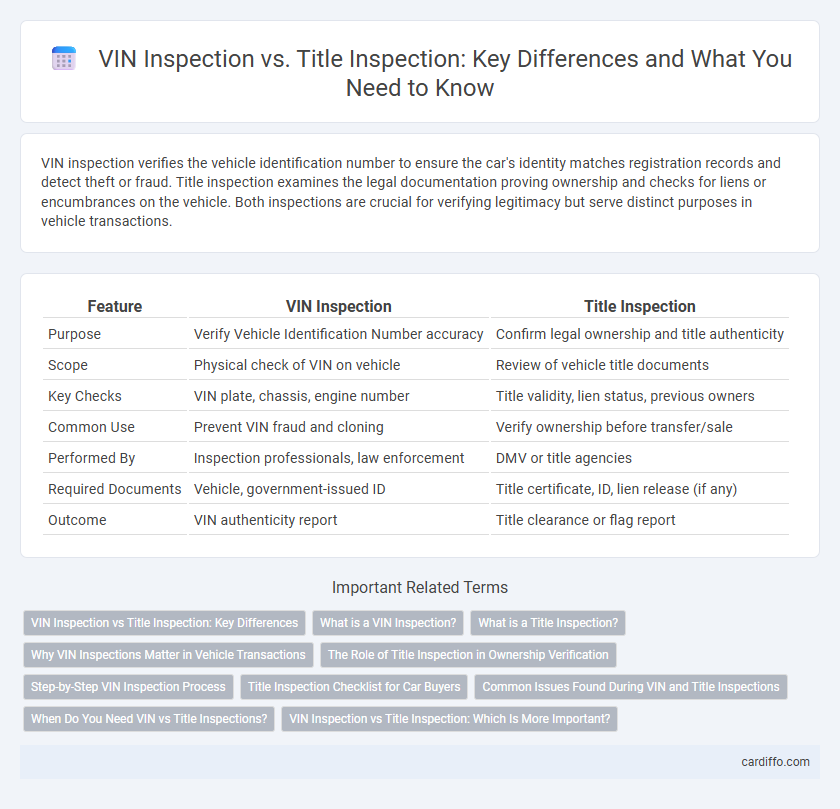VIN inspection verifies the vehicle identification number to ensure the car's identity matches registration records and detect theft or fraud. Title inspection examines the legal documentation proving ownership and checks for liens or encumbrances on the vehicle. Both inspections are crucial for verifying legitimacy but serve distinct purposes in vehicle transactions.
Table of Comparison
| Feature | VIN Inspection | Title Inspection |
|---|---|---|
| Purpose | Verify Vehicle Identification Number accuracy | Confirm legal ownership and title authenticity |
| Scope | Physical check of VIN on vehicle | Review of vehicle title documents |
| Key Checks | VIN plate, chassis, engine number | Title validity, lien status, previous owners |
| Common Use | Prevent VIN fraud and cloning | Verify ownership before transfer/sale |
| Performed By | Inspection professionals, law enforcement | DMV or title agencies |
| Required Documents | Vehicle, government-issued ID | Title certificate, ID, lien release (if any) |
| Outcome | VIN authenticity report | Title clearance or flag report |
VIN Inspection vs Title Inspection: Key Differences
VIN inspection verifies a vehicle's unique identification number to confirm its authenticity and match with registration records, ensuring no theft or fraud. Title inspection, in contrast, involves examining the vehicle's legal ownership document to verify ownership history and lien status. Key differences lie in VIN inspection's focus on physical vehicle identification versus title inspection's emphasis on legal ownership and documentation accuracy.
What is a VIN Inspection?
A VIN inspection verifies the Vehicle Identification Number to confirm a vehicle's identity and ensure it matches official records. This process helps detect fraud, prevents stolen vehicles from being registered, and is often required for out-of-state vehicle transfers or registration renewals. Unlike a title inspection, which verifies ownership documents, a VIN inspection focuses solely on the vehicle's unique identification code.
What is a Title Inspection?
A Title Inspection verifies the ownership history and legal status of a vehicle by examining the title documents to ensure there are no liens, theft records, or discrepancies. This process confirms that the title is clear and the vehicle's ownership rights are legitimate before a sale or registration. Title inspections are crucial for preventing fraud and protecting buyers from potential legal and financial issues.
Why VIN Inspections Matter in Vehicle Transactions
VIN inspections provide a critical verification of a vehicle's identity, ensuring that the chassis number matches official records to prevent fraud and theft. This process safeguards buyers and sellers by confirming the vehicle's history and legitimacy, which title inspections alone cannot guarantee. Accurate VIN verification is essential for legal ownership transfers and helps maintain regulatory compliance in vehicle transactions.
The Role of Title Inspection in Ownership Verification
Title inspection plays a crucial role in ownership verification by confirming the legal owner of a vehicle through official records, ensuring that the title is clear of liens or encumbrances. Unlike VIN inspection, which primarily verifies the vehicle identification number for authenticity and matching physical characteristics, title inspection provides legal assurance of ownership rights. This process helps prevent fraud and facilitates secure vehicle transfers in sales or registrations.
Step-by-Step VIN Inspection Process
The step-by-step VIN inspection process involves verifying the vehicle identification number on the car matches the number listed on official documents, ensuring authenticity and preventing fraud. Inspectors examine the VIN plate, check for tampering or alterations, and compare it with the title, registration, and insurance records. This meticulous procedure contrasts with title inspection, which primarily reviews the vehicle's ownership history and legal status without physically verifying the VIN on the vehicle itself.
Title Inspection Checklist for Car Buyers
A Title Inspection Checklist for car buyers includes verifying the Vehicle Identification Number (VIN) against the title to ensure consistency and detect potential fraud. Inspectors examine the title for liens, ownership history, and any brand labels such as salvage, rebuilt, or flood damage that affect vehicle value and legality. Confirming these details helps buyers avoid legal complications and financial losses associated with undisclosed title issues.
Common Issues Found During VIN and Title Inspections
Common issues found during VIN inspection include mismatched or altered VIN numbers, evidence of tampering, and discrepancies with vehicle records, which can indicate theft or fraud. Title inspections often uncover problems such as lien inconsistencies, incorrect owner information, and title branding errors like salvage or flood damage status. Both inspections are critical for verifying vehicle authenticity and legal ownership, preventing costly disputes and ensuring compliance with state regulations.
When Do You Need VIN vs Title Inspections?
VIN inspections are required when verifying a vehicle's identity, typically during registration, title transfers, or when importing vehicles across state lines to prevent fraud. Title inspections occur to confirm ownership authenticity and ensure there are no liens or legal issues attached to the vehicle's title. Understanding the specific requirements depends on state regulations, with VIN inspections emphasizing physical verification of the vehicle and title inspections focusing on ownership documentation.
VIN Inspection vs Title Inspection: Which Is More Important?
VIN inspection verifies the vehicle's unique identification number to confirm its authenticity and prevent fraud, ensuring the chassis matches registration records. Title inspection focuses on verifying the legal ownership and lien status of the vehicle, safeguarding against stolen or encumbered property. While both inspections serve critical roles, VIN inspection is often more important for confirming the vehicle's identity, especially in transactions involving out-of-state or salvage titles.
VIN inspection vs title inspection Infographic

 cardiffo.com
cardiffo.com